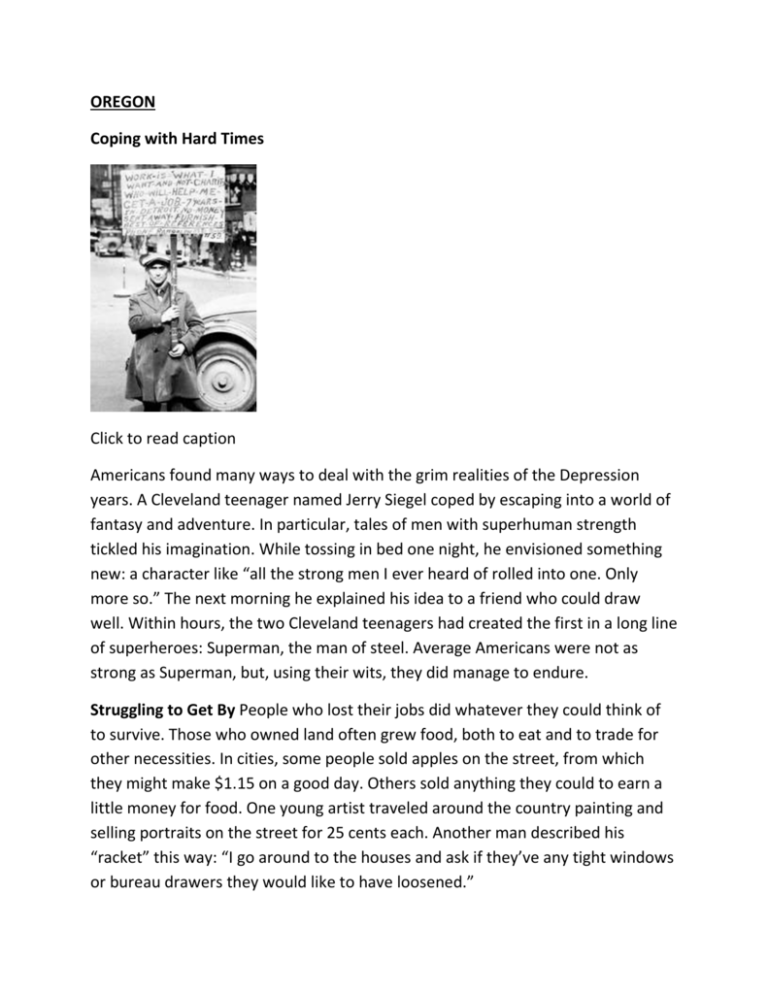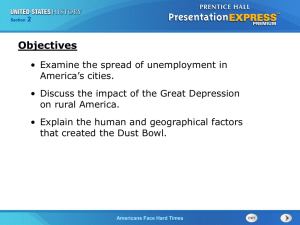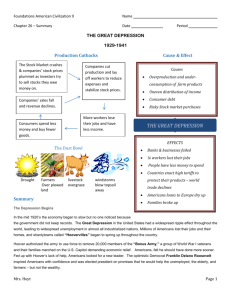State Readings - Strongsville City Schools
advertisement

OREGON Coping with Hard Times Click to read caption Americans found many ways to deal with the grim realities of the Depression years. A Cleveland teenager named Jerry Siegel coped by escaping into a world of fantasy and adventure. In particular, tales of men with superhuman strength tickled his imagination. While tossing in bed one night, he envisioned something new: a character like “all the strong men I ever heard of rolled into one. Only more so.” The next morning he explained his idea to a friend who could draw well. Within hours, the two Cleveland teenagers had created the first in a long line of superheroes: Superman, the man of steel. Average Americans were not as strong as Superman, but, using their wits, they did manage to endure. Struggling to Get By People who lost their jobs did whatever they could think of to survive. Those who owned land often grew food, both to eat and to trade for other necessities. In cities, some people sold apples on the street, from which they might make $1.15 on a good day. Others sold anything they could to earn a little money for food. One young artist traveled around the country painting and selling portraits on the street for 25 cents each. Another man described his “racket” this way: “I go around to the houses and ask if they’ve any tight windows or bureau drawers they would like to have loosened.” Scraping by to meet basic needs, many Americans made sacrifices in all realms of life. The financial crisis forced some 80,000 college students to drop out of school during the 1932–33 school year. Most would never return to complete their education. Middle-class men traded in their white collars for overalls in order to bring home a paycheck. The work might not be what they had once hoped for, but they preferred it to going on government relief. TEXAS: 4. Natural Disasters Intensify the Suffering Click to read caption As the year 1931 began, most farmers on the Great Plains were feeling optimistic. Wheat prices were holding up despite the Depression, and prospects for a recordbreaking crop looked good. That summer, however, the rains abruptly stopped, and crops began to wither; then strong winds began to blow across the plains. As one wheat farmer recalled, “The winds unleashed their fury with a force beyond my wildest imagination. It blew continuously for a hundred hours and it seemed as if the whole surface of the earth would be blown away.” The farmer was hardly exaggerating—he was describing the beginning of one of the worst natural disasters in the nation’s history. Over the course of the next decade, drought, dust storms, and floods would add to the human misery already brought on by the hard times of the Great Depression. Black Blizzards Plague the Great Plains At first, farmers on the Great Plains viewed the disastrous summer of 1931 as a freak of nature. The following year, they once again planted their fields and waited for the rain needed to nourish their crops. However, that rain never came—not that summer, nor the summers that followed. The prolonged drought devastated farmers, who could not get their land to produce anything but dust. As disruptive as the drought was, the dust storms proved to be worse. Winds whipping across the plains picked up the dried-out topsoil and formed ominous black clouds. The blowing dust became so thick that people called the storms black blizzards. As one eyewitness recalled decades later, Click to read caption The wind kept blowing harder and harder. It kept getting darker and darker. And the old house is just a-vibratin’ like it was gonna blow away. And I started trying to see my hand. And I kept bringing my hand up closer and closer and closer and closer. And I finally touched the end of my nose and I still couldn’t see my hand. That’s how black it was. People tried to protect themselves by covering their faces with pieces of cloth and tacking sheets over doorways, but these efforts did little good. By the time a storm ended, one housewife reported, “Everything was full of dust.” The prolonged drought affected 100 million acres of farmland in Texas, Oklahoma, New Mexico, Colorado, and Kansas. A journalist traveling through the region at the time described it as a Dust Bowl—a name that stuck. Click to read caption The Natural Impact of the Drought: Desertification In 1932, the weather bureau reported the occurrence of 14 dust storms. Within a year, the number nearly tripled, reaching 38. The Great Plains was experiencing desertification, a process in which land becomes increasingly dry and desertlike. Several factors contributed to the desertification of the Great Plains. Drought, of course, was one, since without rain nothing would grow in farmers’ fields. Decades of poor farming practices worsened the situation. During World War I, the federal government had encouraged farmers on the Great Plains to raise as much wheat as possible. After the war, as crop prices dropped, farmers had tried to increase their harvests even more to make up the difference. To do this, they had plowed and planted every tract of land they owned. By 1930, Great Plains farmers were harvesting far more wheat than they had been 10 years earlier, and they were also grazing more cattle. Such intensive use of the land depleted the soil of nutrients and left it stripped of its native drought-resistant vegetation. Once the drought came, there was no plant covering to hold the soil in place. The wind easily picked it up and blew it away. In 1935, the federal government responded to the loss of so much valuable topsoil by establishing the Soil Conservation Service. The service promoted new farming methods designed to reduce soil erosion. It planted about 18,000 miles of trees to act as windbreaks, reducing the force of winds blowing across the plains. Click to read caption The Human Impact of the Drought: Depopulation Although the federal government geared up to combat the drought, it took action too late for many farmers. During the 1930s, a quarter of the people living in the Dust Bowl left the region. Some had no option but to depart after banks foreclosed on their farms. Others moved away because breathing in the dust was making their families sick. Still others simply gave up, loading their possessions into a car or truck and driving away. As the dry years piled up, depopulation, or the loss of residents from an area, took a heavy toll on the region. With their customers moving away, banks and business failed. Since few students arrived to fill classrooms, schools closed. Even churches shut their doors, as few people remained to come together in prayer on Sundays. Once-bustling farming communities turned into ghost towns. Click to read caption Some of the Dust Bowl refugees headed for nearby cities in hopes of finding work. However, with the unemployment rate still high, jobs were scarce, so many more people left the region entirely. Like the fictional Joad family in John Steinbeck’s novel about Dust Bowl migrants, The Grapes of Wrath, those who left often followed U.S. Route 66 to California. California appealed to migrants for its promise of farmwork in the fertile Central Valley. Californians nicknamed the newcomers Okies because many of them came from Oklahoma. NEW JERSEY: Millions Face Hunger and Starvation In addition to homelessness, loss of work often led to hunger. For many, going hungry was a new experience. One teenager who left home to find work later recalled, “I was hungry all the time, and I wasn’t used to hunger. I’d never been hungry before, dreadfully hungry.” In a letter to Eleanor Roosevelt, another teenager reported, “My brother and I some times even went to bed with out supper because we understand that the others [in our family] need it more than we do.” Hunger led to malnutrition—a physical condition that results from not getting an adequate diet of healthy food—among the poor. According to surveys conducted in the 1930s, as many as one in five children in New York endured malnutrition at the peak of the Depression. In coal-mining areas, childhood malnutrition rates may have risen as high as 90 percent. Lack of proper nutrition left people vulnerable to diseases. One study reported that the illness rate among families of the unemployed soared to 66 percent higher than that of families with a full-time wage earner. Not surprisingly, the poor could rarely afford the medical care their sicknesses required. People did their best to feed themselves and their families. Some picked through garbage cans looking for scraps, some stole, and still others begged. Families were known to subsist on potatoes, crackers, or dandelions. Lorena Hickok witnessed desperate mothers in South Dakota feeding their children a soup made of Russian thistle, a plant Hickok likened to barbed wire. Reporter Louis Adamic described being at home one morning when his doorbell rang. He looked out expecting to see the postman. Instead, he saw a girl, as we learned afterward, of ten and a boy of eight. Not very adequate for the season and weather, their clothing was patched but clean. They carried school books. “Excuse me, Mister,” said the girl in a voice that sounded older than she looked, “but we have no eats in our house and my mother said I should take my brother before we go to school and ring a doorbell in some house”—she swallowed heavily and took a deep breath—“and ask you for something to eat.” —Louis Adamic, My America, 1938 To feed the hungry, soup kitchens sprang up across the country. Soup was easy to prepare and could be increased in order to feed more people by adding water. Breadlines—long lines of people waiting for their bowl of soup and piece of bread—became a common sight in most cities. For many, that soup kitchen meal was the only food they would eat all day. At one point, New York City had 82 soup kitchens, which provided the needy with 85,000 meals a day separately or to pay the legal fees involved in a divorce. OHIO: Evictions Force People Out of Their Homes Without a steady income—or sometimes any income at all—many people could not pay their rent. When they failed to pay, their landlords would evict them. Eviction is a legal process that landlords use to remove tenants from their property. Similarly, if homeowners could not make their monthly mortgage payments, banks would foreclose on their homes, forcing families to find shelter elsewhere. Those who became homeless did their best to get by. Some crowded into apartments with other families, huddling together against the cold when they could not afford fuel for heat. Others slept on park benches, in doorways, or, as one young homeless man reported, in haystacks, tobacco warehouses, a YMCA, a Salvation Army shelter, and jails. Once he even pried open a church window, climbed in, and pulled two seats together to make a bed. As an increasing number of people lost their homes, Hoovervilles sprang up around many cities. Seattle’s Hooverville consisted of more than 200 shacks made of tarpaper, old crates, and other scrap materials. City officials tried twice to get rid of the makeshift village by burning the shacks to the ground. When that did not work, they agreed to leave the residents alone. Although divorce rates dropped during the 1930s, desertion rates rose. Some men, finding themselves unable to support their families, left home to live on the streets. “These are dead men,” one writer observed. “They are ghosts that walk the streets by day. They are ghosts sleeping with yesterday’s newspapers thrown around them for covers at night.” Teenagers also left home, often to ride the railroads in search of work. Hopping on and off moving freight trains, however, carried its own set of dangers. “I nearly was killed on my first train ride,” one man who left home at 16 later recalled. “All I could think of was I shouldn’t have got on this train. And if I lose my grip I’m gonna die. And what would my mother think?” ILLINOIS: Rising Unemployment Affects Millions of Americans From 1929 to 1933, almost one in every seven businesses failed. In 1933, when Lorena Hickok began her travels, 13 million Americans were out of work. That number amounted to about 25 percent of the workforce. In comparison, only about 3.1 percent of the population had been jobless before the stock market crash in 1929. Most unemployed Americans wanted to work. Losing their jobs was a crushing blow to people who were accustomed to providing for their families and who believed in the American ideal of opportunity for all. Those who did manage to keep their jobs often found their hours—and their pay—reduced. When companies had to lay people off, they first let go of very young, elderly, and minority workers. African American unemployment rose as high as 50 percent in some cities during the Depression. When the New Deal began in 1933, about 20 percent of people listed on government relief rolls were African Americans, even though they made up only about 10 percent of the population. At first, the economic collapse struck men harder than women. Men tended to work in heavy industries like automobile assembly and steelmaking, which were badly hit by the downturn. Sectors of the economy in which women tended to work declined less. Female secretaries, waitresses, maids, and telephone operators often kept their jobs, at least at first. As the Depression wore on, employers began firing women to give the jobs to men with families to support. Many states refused to hire women for government jobs if their husbands earned a living wage, or a wage high enough to provide an acceptable standard of living. Unemployment had a cascading effect. The unemployed had little to spend, so many businesses lost customers and had to close—increasing unemployment. In addition to losing their jobs, many people lost their savings and their homes. NORTH DAKOTA: Farmers Lose Their Farms Farmers had faced economic troubles even before the Depression began. But as unemployment reduced consumers’ buying power, many farmers could no longer sell their crops. As a result, they could not make mortgage payments to banks that had loaned them money. In desperation, some farmers tried to sell their farms—only to find that their property values had sunk along with the economy. Property value tells what a piece of real estate is worth on the market. During the Depression, many farms lost more than half their value. Click to read caption Farmers who could find buyers often received far less for their land than they had paid for it. Those who could not sell their farms lost them to foreclosure, a legal process that allows a lender to take over the property it has helped a borrower buy. Farm families that went through foreclosure lost their homes, their livelihoods, and all the money they had invested. Tenant farmers and sharecroppers in the South suffered the most, for these farmers, both black and white, could not afford to buy land. Instead they rented it, borrowing money from the owner to purchase seeds and other supplies. Typically, they did not earn enough selling their crops to cover their debts and rent. To make matters worse, in Mississippi the average annual income per person fell from a meager $239 in 1929 to a pathetic $117 by 1933. When tenant farmers and sharecroppers could no longer pay rent, some landowners forced them to leave. PENNSYLVANIA: From Drought to Deluge: The Great Flood of 1936 While the Great Plains suffered from drought, a different natural disaster—the Great Flood of 1936— struck the Northeast. In March 1936, a series of heavy storms pounded the region. The rain, combined with heavy melting snow, caused rivers to spill over their banks. Floodwaters inundated cities, towns, farms, and mines. The New York Times wrote of the disaster: “From New England to the Potomac scores of communities stand under water as their inhabitants row in boats past homes submerged to the eaves.” The Great Flood of 1936 hit Pennsylvania the hardest of all states in the region. Across the state, the flood caused the deaths of 84 people and the destruction of more than 82,000 buildings. The disaster paralyzed Pittsburgh, a leading industrial city in the western part of the state. Floodwaters knocked out the city’s electricity and telephone service. Fires burned unchecked because fire trucks could not travel through flooded streets. Without power, the city’s water system shut down. On March 20, 1936, the Pittsburgh Sun-Telegraph reported to its readers, Water famine hit devastated Pittsburgh today. The specter [ghost] of thirst and pestilence [infectious disease] joined the twin horror of fire and flood. Squirrel Hill was the first to feel the blow. Water faucets trickled dry early today. In other sections of the city supplies will be exhausted within a few hours. The rising rivers called the government’s attention to a new concern: the safety of the nation’s capital. As Congress debated the creation of a national flood-control program, members of the Civilian Conservation Corps labored feverishly to build a sandbag levy around the Lincoln Memorial and the Washington Monument, which were located not far from the Potomac. In the past, lawmakers had offered only weak support for flood-control measures. However, after the floods of 1936, Business Week reported, flood-control legislation “has tremendous support in Congress.” Within weeks, President Roosevelt signed a national flood program into law. Click to read caption Financial Woes Stress American Families Families suffered not only financial but also psychological stress when breadwinners lost their jobs. Many jobless men and women felt ashamed of being unemployed, believing they had brought it on themselves. Men also often felt that they lost status and authority within their families when they lost their jobs. One unemployed man put it this way: “During the depression, I lost something. Maybe you call it self-respect, but in losing it I also lost the respect of my children, and I am afraid that I am losing my wife.” For some Americans, these strains were too much to take. The suicide rate reached an all-time high during the Depression. Families struggled to stay together during the lean years. Those who could not afford rent sometimes squeezed in with relatives or friends. But when costs rose too high, thousands of people, many of them teenagers, left home. One man recalled that when he turned 16, his father told him, “Go fend for yourself. I cannot afford to have you around any longer.” GEORGIA: Looking for Help Despite people’s efforts, the day often came when even the proudest family had to look for relief. However, as Lorena Hickok heard repeatedly on her travels, many found it difficult to admit they needed help. Before he could seek relief, “I simply had to murder my pride,” an engineer explained to her. Similarly, an unemployed insurance agent confessed, “We’d lived on bread and water three weeks before I could make myself do it.” Before Franklin Roosevelt launched his New Deal in 1933, there were few places the poor and unemployed could turn for help. Herbert Hoover had believed that private charities could cope with the economic crisis, as they had with earlier downturns, and he had encouraged Americans to rely on them to do so. Many wealthy Americans generously supported charities to help the less fortunate. In New York City, charitable donations for the needy increased from $4.5 million in 1930 to $21 million in 1932. Click to read caption At times, charity also came from unexpected sources. For example, the notorious gangster Al Capone and his gang established the first soup kitchen in Chicago in 1930. Capone hoped that this act of charity would help clean up his shady image and keep him out of jail. It did not—he was tried and convicted of income tax evasion the following year. Local and state governments also attempted to aid people who were out of work. They offered public assistance —support in the form of money, goods, or services provided to those in need. However, local and state relief agencies soon drained their funds. There were simply too many people in need of help. “I have seen thousands of these defeated, discouraged, hopeless men and women, cringing and fawning as they come to ask for public aid,” reported the mayor of Toledo, Ohio. “It is a spectacle of national degeneration.” Harry Hopkins, the man who had hired Hickok, agreed with the mayor’s sentiment. In his first few months as director of the Federal Emergency Relief Administration, an agency established to grant money to states for relief projects, he had come to understand that doling out his limited funds would not adequately deal with the crisis. He knew that putting people back to work—and soon—was imperative. When his critics argued that doing more would cost too much, Hopkins responded bluntly, “Hunger is not debatable. People don’t eat in the long run—they eat every day.”



![Historical_politcal_background_(intro)[1]](http://s2.studylib.net/store/data/005222460_1-479b8dcb7799e13bea2e28f4fa4bf82a-300x300.png)


